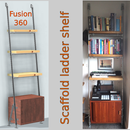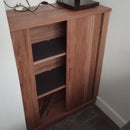Introduction: Massive Steel Barrel Clock
I have to confess that this project didn't end up as it was supposed to. I originally intended to attempt to make a steel pan drum with this metal barrel but after sinking the lid half way down I got a tear in the metal so had to abandon that idea. I think the tear happened as my hammer wasn't round enough......you can see some of the hammer lines are linear rather than a circular dent and I think this is what caused the crack. If I go back the steel pan drum I might try sinking the lid with a heavy shot put rather than a hammer and see how that turns out.
As a warning if you do attempt to do something like this be ready to hammer for hours and get very tired arms!!
Anyway, left with a ruined drum I decided to salvage it by making a rather large, industrial style, imposing clock......
Supplies
Materials
Metal barrel
Machine screws
Rivets
Car trim edging
Clock movement and hands
Spray paint
Tools
Heavy hammer / lump hammer
Angle grinder with cut off disk
Pop rivetter
Drill and drill bits
Step 1: Sinking the Barrel Bottom
I started by removing the lid so the air had somewhere to go when I was hitting it, and placed it on a blanket to try and muffle the noise at least a little bit. Luckily I live in a detached house so have no attached neighbours as hammering a barrel is extremely loud. Ear defenders are a must with this project.
I started by drawing some concentric rings around the surface so I could gauge easier where abouts I was in the hammering process. I stared hammering around the outer edge of the lid and once I was all the way round I moved the hammer slightly closer to the centre and kept on going round the barrel. I did hammer lighter as I got closer to the middle as the metal would be easier to tear the more central you are. I generally moved myself rather than the hammer or barrel which seemed to work okay.
As a bit of a change I also hammered in a second patter which was to hammer from the outside edge to the middle in a line and then repeat all the way around the barrel.
Do this repeatedly for hours until you have sunk the lid enough. For the steel pan drum I wanted to make the middle would have had to be sunk to around 200mm (8in), I got to 110mm (4.5in) before I got a tear......this involved around three hours of hammering (not all at once, I'm not Thor).
Step 2: Cut to Size
Once I had decided that I was going to make a clock I cut the bottom of the barrel of around 25mm (1in) above the highest point, marking this with a pencil and using an angle grinder with a thin cut-off disk to remove this part from the rest of the barrel. Once cut I could get a good look at my convex surface.
Step 3: Mount the Clock Mechanism
I started by marking the centre of the clock (by using a series of straight lines and the eye) and drilling an appropriate size hole for the clock mechanism.
To keep the quartz movement moving around I epoxied four bits of plywood it could sit within. The mechanism itself had a screw thread to hold it in place.
Step 4: Create the Hour Points
To mark the hour points I first established the quarter points. This is quite difficult on a convex surface so did quite a bit by eye but utilised a large square to make sure they were marked close enough square to each other. I then marked them with a flexible bit of hardboard and a pencil. Before I drilled these holes I measured in between each adjacent hole to make sure they were about the same distance from each other. I wanted to make the quarter point markers to be larger than the rest so drilled 6mm (1/4in) holes in them so I could put machine bolts through them.
I then used similar a technique to mark the rest of the hour points, before checking, then remarking as they were wrong, checking and then drilling with a small drill bit so they would accept some small rivets.
Step 5: Hanger
I needed to add a hanger so I cut a key hole slot in a bit of scrap wood using a key hole router bit on the router table. I then screwed this to a small bracket.
I marked the position of the bracket on the clock (so the edge of the wood was flush with the rim), drilled two holes and used my riveter to attach it to the clock.
Lastly I bent the fixing so it was flush with the back. I couldn't to this pre-fix as the riveter would get in the way.
Step 6: Spray Painting
Last time I needed some spray paint I went to Halfords (a car parts shop) and found a basket of reduced spray paints....probably from old car models, so I bought a few. For the clock I went for a metallic Volvo Dark Blue, I didn't know exactly what shade it was going be before spraying but it looks pretty nice.
I stated off by spraying the gold coloured hands as gold really isn't my favourite colour. I then masked off the convex part of the clock so I could paint the inside and outside of the rim, leaving the centre as it was.
I then sprayed a few layers of paint on the clock (leaving an hour or so between layers) until I ran out of paint!
Step 7: Add the Harware
Finally I just needed to add the hardware.
I started by adding machine bolts to the 12, 3, 6 and 9 positions and then added pop rivets to the rest of the hour markers.
I then attached the quartz mechanism, fixed it in place and added the hands being careful not to bend them. I then span the hands round to make sure they didn't clash and finished by adding a battery.
Step 8: Finished
All I then needed to do was to find a place for my clock. Being quite large it didn't fit in very many places but in the end we found the perfect place for it, just above out coat hangers in the dining room.
In the end it wasn't quite what I intended, and nowhere close to a steel pan drum, but I very pleased with my clock.
Not as pleased with the hours of hammering I had to do though!
Thanks for reading.

Participated in the
Metalworking Contest













